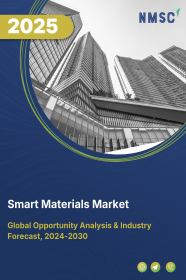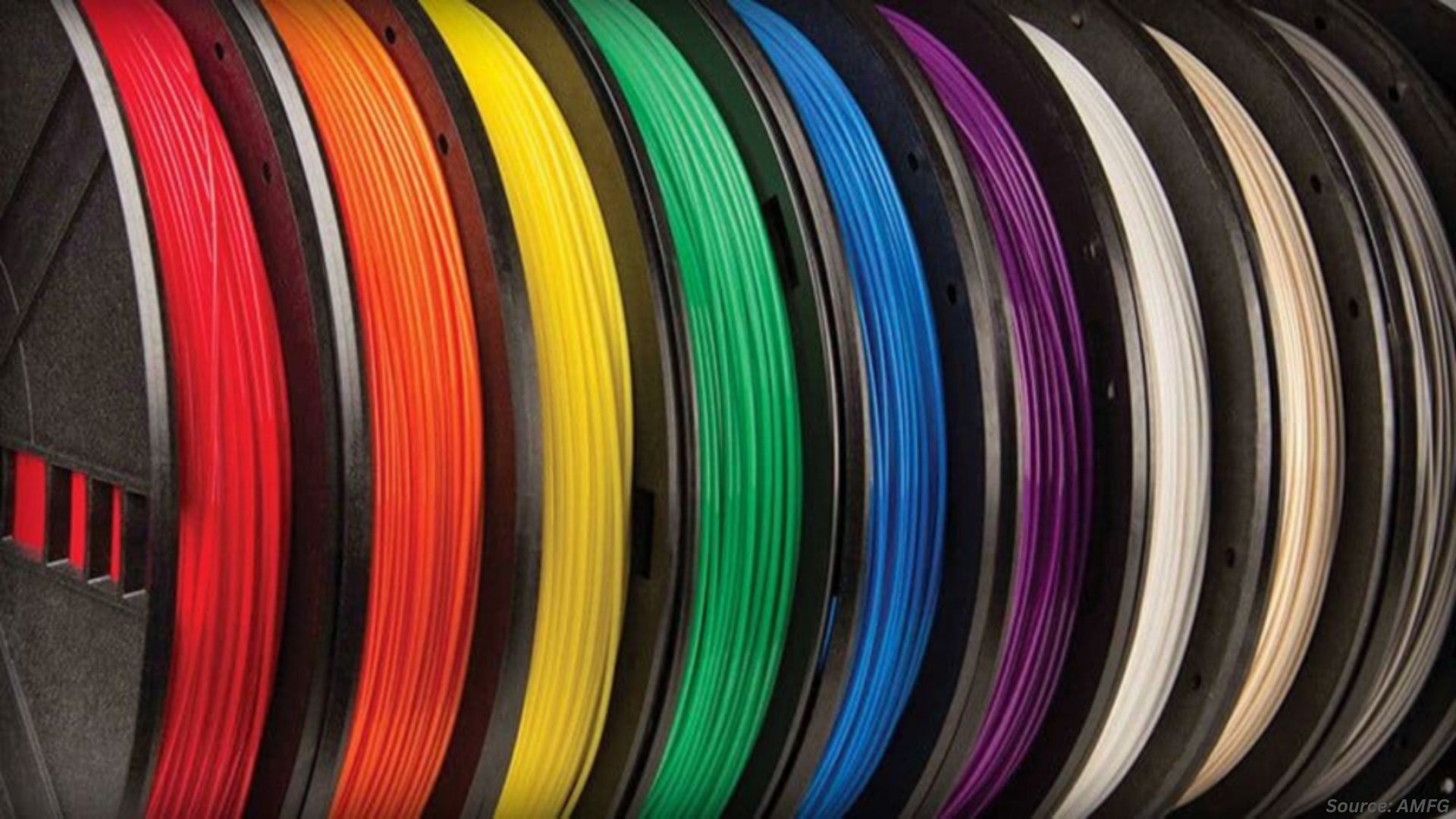
Smart Materials Market by Product Type (Piezoelectric Materials, Electrostrictive Materials, Magnetostrictive Materials, Shape-memory Alloy Materials, Electrochromic Materials, Phase Change Materials, and Others), by Application (Transducers, Actuators & Motors, Sensors, Packaging, Structural & Building Materials, and Others), and by End-User (Industrial, Defense & Aerospace, Automotive, Healthcare and Others) – Global Opportunity Analysis and Industry Forecast – 2025 – 2030
Smart Materials Market Overview
The global Smart Materials Market size is estimated at USD 68.78 billion in 2024 and is predicted to reach USD 115.97 billion by 2030 with a CAGR of 9.1% from 2025-2030.
The factors such as the rise in automobile sale, increasing investment in R&D, and growing military expenditure in smart materials drives the market growth.
However, the limited availability of these materials poses significant challenges to market expansion. On the contrary, the technological advancements offer promising future opportunities to enhance product functionality and improve user experience.
Moreover, the top players such as TDK Corporation, CTS Corporation, and PI Ceramic GmbH are taking various initiates such as product launch and partnerships in order to enhance their market expansion.
These initiatives are expected to enhance user convenience and performance. With innovations, companies are focusing on developing product with better functionality performing efficient operations. As the market matures, the increasing demand for more advanced, high-performance devices is expected to fuel further growth.
Rise in Automotive Sale Worldwide Boost the Smart Materials Market Growth
The demand for smart materials is gaining traction because of the growth in vehicle sales, as automotive producers are progressively using these materials to boost vehicle performance, lessen weight, and enhance energy efficiency.
According to the latest report by the International Energy Agency, sales of vehicles grew by 5%, going from 72.8 million to 76.6 million cars from 2022 to 2023. These materials enable advanced functionalities, such as adaptive structures and self-heating coatings, meeting the demand for innovative, sustainable, and high-performance automotive solutions.
Increasing Investment in Research and Development Drives the Market Growth
The increasing investment by various companies in the research and development of responsive materials fuels market growth, as these efforts drive the creation of advanced materials with enhanced functionalities.
For instance, in September 2024, Li Auto united with Covestro to develop a joint innovation platform focusing on smart materials advancements for automotive applications. The development of innovative products from R&D projects leads to applications in aerospace implementations and automotive manufacturing alongside healthcare solutions and construction applications which fulfill rising market needs for efficient sustainable high-performance technologies.
Growing Military Spending Worldwide Fuels the Smart Materials Market Demand
Rise in military spending fuels the smart materials market as defense sectors prioritizes advanced technologies for improved performance and durability in applications like armor systems, aerospace components, and surveillance equipment.
According to the recent report published by the Stockholm International Peace Research Institute (SIPRI), the global military expenditure reached at USD 2,443 billion in 2023 an increase of 6.8% from 2022. Higher budgets allocated to modernizing military infrastructure and equipment accelerate the adoption of innovative materials, driving market expansion.
Limited Availability of Smart Materials Hinders the Smart Materials Market Expansion
The limited availability of smart materials results in high purchasing costs as the suppliers of these materials charge high rates for the components. It results in high production costs for the end-use industries which are expected to restrain the growth of the market.
Technological Advancements Creates Future Opportunities
On the other hand, innovations in smart materials is expected to create ample growth opportunity for the market in the future. This will facilitate enhanced capabilities across sectors like healthcare, aerospace, automotive, and consumer electronics.
For instance, in August 2024, researchers at the University of Waterloo have developed a groundbreaking fabric that can generate electricity from body heat. This innovative material converts body heat and harnesses solar energy, providing a continuous power source for wearable devices, paving the way for transformative applications and enhanced market opportunities.
Market Segmentation and Scope of Study
The smart materials market report is segmented on the basis of product type, application, end-user, and geography. Based on product type, the market is classified into piezoelectric materials, electrostrictive materials, shape-memory alloy materials, electrochromic materials, phase change materials, and others. Based on the application, the market is segmented into transducers, actuators & motors, sensors, packaging, structural & building materials, and others. On the basis of end user, the market is categorized into industrial, healthcare, defense & aerospace, automotive, consumer electronics, and others. Geographical breakdown and analysis of each of the aforesaid classifications include regions comprising North America, Europe, Asia-Pacific, and RoW.
Geographical Analysis
North America dominates the smart materials market share at present and is projected to continue its dominance throughout the forecast period. This is attributed to the growing military expenditure that leads governments to invest more in modernizing its defense technologies.
Self-healing materials combined with shape-memory alloys improve military equipment functionality while increasing demand and expanding the market. As per latest PBO forecast, Canada’s military expenditure will rise from 1.29% GDP in 2024-2025 to 1.49% of GDP in 2025-2026, reflecting a significant focus on defense advancements.
Moreover, rise in healthcare spending is significantly driving the growth of the market. Healthcare investments result in increased demand for sophisticated medical devices which demand advanced diagnostic tools alongside implants made from these materials.
As per Centers for Medicare and Medicaid Services, the U.S. healthcare spending reached USD 4.9 trillion and increased 7.5% in 2023 from 4.6% in 2022. Consequently, the boost in healthcare spending accelerates innovation and adoption of these materials, fostering growth in the market.
On the other hand, Asia-Pacific is considered fastest growing region in the smart materials owing to rise in automobile sale as manufacturers focus on creating lighter, more efficient vehicles to meet fuel economy and emission standards for which they have to rely on these materials.
According to the report issued in 2024 by the Institute for Management Development, China now became the most significant automotive production sector in the world, with over 30 million vehicles in 2023. This surge increases demand for advanced materials to reduce vehicle weight and enhance safety features and sustainability.
Also, the rapid growth of the semiconductor industry in India is driving the expansion of smart materials. As India strengthens its semiconductor manufacturing capabilities, the demand for these materials increases as it relies on semiconductors for functionality in various applications like sensors.
As per India Brand Equity Foundation, the Indian semiconductor market was valued at USD 26.3 billion and is projected to expand at a CAGR of 26.3% to USD 271.9 billion by 2032. This growth in semiconductor production fuels innovation in such materials, particularly in sectors like electronics, automotive, and healthcare, thereby driving market expansion.
Competitive Landscape
Smart materials industry comprises of several market players such as TDK Corporation, CTS Corporation, PI Ceramic GmbH, CeramTech GmbH, APC International Ltd, OliKrom, Fort Wayne Metals, Parker Hannifin Corporation, Stryker Corporation, Smart Material Corporation, KYOCERA Corporation, Arkema Group, Solvay, TRS Technologies, Inc., QorTek, Inc., and others. These market players are adopting various strategies including product launch to maintain their dominance in the industry.
For instance, in June 2024, TDK Corporation launched a new material for its next-generation solid-state battery with higher energy density, making it suitable for various wearable devices like wireless earphones, hearing aids, and smartwatches.
Furthermore, in June 2024, PI Ceramic launched new product category that is Piezoceramic composites, which utilizes an innovative manufacturing technology to embed piezoelectric ceramics within filing polymers.
Key Benefits
-
The report provides quantitative analysis and estimations of the smart materials market from 2025 to 2030, which assists in identifying the prevailing market opportunities.
-
The study comprises a deep-dive analysis of the current and future smart materials market trends to depict prevalent investment pockets in the market.
-
Information related to key drivers, restraints, and opportunities and their impact on the market is provided in the report.
-
Competitive analysis of the key players, along with their market share is provided in the report.
-
SWOT analysis and Porters Five Forces model is elaborated in the study.
-
Value chain analysis in the market study provides a clear picture of roles of stakeholders.
Smart Materials Market Key Segments
By Product Type
-
Piezoelectric Materials
-
Electrostrictive Materials
-
Magnetostrictive Materials
-
Shape-memory Alloy Materials
-
Electrochromic Materials
-
Phase Change Materials
-
Others
By Application
-
Transducers
-
Actuators & Motors
-
Sensors
-
Packaging
-
Structural & Building Materials
-
Others
By End User
-
Industrial
-
Defense & Aerospace
-
Healthcare
-
Automotive
-
Consumer Electronics
-
Others
By Region
-
North America
-
The U.S.
-
Canada
-
Mexico
-
-
Europe
-
The UK
-
Germany
-
France
-
Italy
-
Spain
-
Denmark
-
Netherlands
-
Finland
-
Sweden
-
Norway
-
Russia
-
Rest of Europe
-
-
Asia-Pacific
-
China
-
Japan
-
India
-
South Korea
-
Australia
-
Indonesia
-
Singapore
-
Taiwan
-
Thailand
-
Rest of Asia-Pacific
-
-
RoW
-
Latin America
-
Middle East
-
Africa
-
Key Players
-
TDK Corporation
-
CTS Corporation
-
PI Ceramic GmbH
-
CeramTech GmbH
-
APC International Ltd
-
OliKrom
-
Fort Wayne Metals
-
Parker Hannifin Corporation
-
Stryker Corporation
-
Smart Material Corporation
-
KYOCERA Corporation
-
Arkema Group
-
Solvay
-
TRS Technologies, Inc.
-
QorTek, Inc.
REPORT SCOPE AND SEGMENTATION:
|
Parameters |
Details |
|
Market Size in 2024 |
USD 68.78 Billion |
|
Revenue Forecast in 2030 |
USD 115.97 Billion |
|
Growth Rate |
CAGR of 9.1% from 2025 to 2030 |
|
Analysis Period |
2024–2030 |
|
Base Year Considered |
2024 |
|
Forecast Period |
2025–2030 |
|
Market Size Estimation |
Billion (USD) |
|
Growth Factors |
|
|
Countries Covered |
28 |
|
Companies Profiled |
15 |
|
Market Share |
Available for 10 companies |
|
Customization Scope |
Free customization (equivalent up to 80 working hours of analysts) after purchase. Addition or alteration to country, regional, and segment scope. |
|
Pricing and Purchase Options |
Avail customized purchase options to meet your exact research needs. |




















 Speak to Our Analyst
Speak to Our Analyst

























